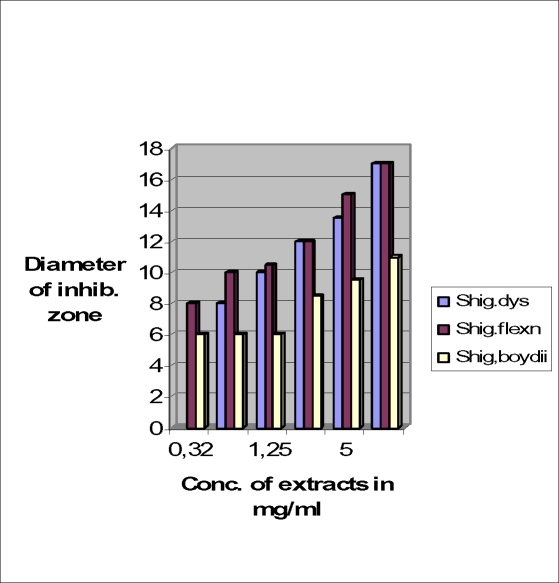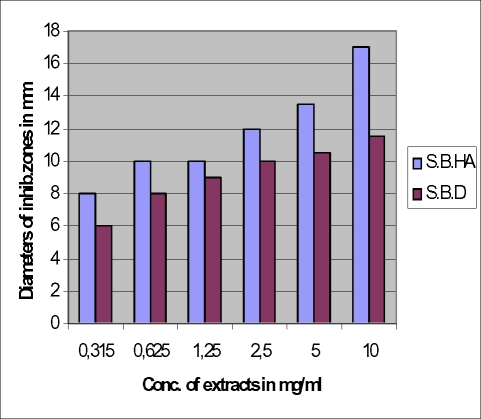Abstract
Total and hydroalcoholic extracts of the stem barks of Parkia biglobosa (Jacq) Benth. (Mimosaceae) were tested on strains belonging to three species of Shigellae: S. dysenteriae, S. flexneri and S. boydii collected from hospitals in Ouagadougou, Burkina Faso. The results showed that both extracts were active against Shigellae. The hydroalcoholic extract was more active than the decoction (aqueous one) prescribed by the traditional healer. Both extracts were particularly effective against S. dysenteriae, the most virulent of the three pathogenic species. The effects of the extracts have been compared to that of gentamicin. The phytochemical screening on the extracts revealed the presence of sterols, triterpenes, polyphenolic compounds including tanins, flavonoids, coumarins, anthocyanidins. Other components are saponosides and reducing sugars.
Keywords: Shigellae, Hydroalcoholic extract, bark, Parkia biglobosa
Introduction
Shigellae are highly infectious organisms causing a high rate of mortality in developing countries (Berche et al., 1988). Human beings are recognized to be the main hosts of pathogenic shigellae. They are transmitted by food, fingers, feces and flies. Shigella dysenteriae is the most virulent among all the species of Shigella. The other pathogenic ones are S. Sonnei, S. Flexneri, and S. Boydii (Brooks et al, 1998). Shigella dysenteriae causes the bacillary dysentery (diarrhoea with blood) from the mucuous membrane of the large intestine producing a virulent enterotoxin and causing the most severe form of infection (Stucke, 1993).
The antibiotics currently used for the treatment of shigellosis are ciprofloxacin, ampicillin, tetracyclin, trimethoprim sulfamethoxazole (Stucke et al 1988; Berche et al., 1988; Brooks et al., 1998)), which are out of the reach of most of the African populations.
It was reported that stem bark of Parkia biglobosa (Jacq) Benth. was successfully used in the treatment of many infectious diseases: dental caries, pneumonia, bronchitis, violent stomachaches, severe cough, diarrhoa, wounds, otitis, dermatosis, amoebiasis, bilharziosis, leprosis, ankylosis, tracheitis, conjunctivitis and others like haemorrhoids. The barks were also successfully used against jaundice and hypertension, the seeds, for the treatment of arterial hypertension, the leaves, against piles, amoebiasis, bronchitis, cough, burn, zoster, abcess, and combined with the roots they are active against dental caries, conjunctivitis (Kerharo, 1973; Maydell, 1983; Nacoulma, 1996), Arbonnier (2002), ).
Our objective was to test the efficiency of the stem barks of Parkia biglobosa on pathogenic species of Shigellae in order to produce ameliorated traditional drugs affordable to most of the populations as our contribution to the fight against poverty.
Methodology
The plant material was collected in May 2003 at Yako, a village located at 109 Km from Ouagadougou, Burkina Faso and voucher specimen was deposited in herbarium of University of Ouagadougou. It was taxonomically identified by Prof J. Millogo, a botanist from University of Ouagadougou. Powder of the stem bark of Parkia biglobosa was subjected to aqueous decoction. A second extract was obtained with boiling 70% ethanol (i.e., water-:ethanol 3:7) . Both extracts were freeze-dried and tested on three species of Shigellae (S. dysenteriae, S. flexneri, and S. boydii) to determine their antimicrobial effects. The strains were isolated from urines, pus and blood obtained from patients. Three strains of each species were used for the antimicrobial tests. Gentamicin was used as a positive control. Sex and age were not taken into account. The antimicrobial activity was determined by the agar-well diffusion method (Perez et al.., 1990). The phytochemical screening was conducted according to the standard methods and the concentration of the polyphenolic compounds determined by the complexiometric dosage of Folin Denis.
Results
The results of the phytochemical screening are shown in Table 1. This table indicated that the stem bark of Parkia biglobosa contains sterols, triterpenes, polyphenolic compounds including tanins, flavonoids, coumarins, anthocyanins and also saponosides and reducing sugars. The alkaloids are absent. The spectrophotodensitometric dosage of the phenolic compounds revealed that the stem bark contained 0.35 ± 0.02 % eq. tannic acid.
Table 1.
Phytochemical screening of the stem bark of Parkia biglobosa − : absent; ++: abundant; + : present; +++: very abundant; ±: traces
| Solvents of increasing polarity | Chemical coumpounds | Stem bark |
| Chlorofom (CHCl3) | Sterols and triterpens | +++ |
| Emodols | − | |
| Alkaloids | − | |
| Coumarins | + | |
| Flavonones | ± | |
| Anthocyanins | +++ | |
|
Ethanol - Water (EtOH- H2O - 70:30) |
Reducing coumpounds | +++ |
| Tannins | ++ | |
| Anthracenosides | + | |
| Saponosides | +++ | |
| Alkaloids | − |
The results of the antimrobial tests are shown in Figures 1 and 2.
Figure 1.
Antimicrobial effects of the hydroalcoholic extract of stem bark on S. dysenteriae, S. flexneri and S. boydii. The diameter of the inhibition zone obtained with the gentamicin is 31 ± 0.2 mm at 5µg/ml.
Figure 2.
Comparative study of the hydroalcoholic and the aqueous extracts of the stem bark of Parkia biglobosa (Jacq.) Benth (Mimosaceae) on S. dysenteriae
S.B.HA = Stem Bark hydroalcoholic extract
S.B.D = Stem bark decoction
Discussion
The stem bark of Parkia biglobosa is rich in sterols and triterpens, tannins, saponosides, anthocyanins and reducing compounds (Table 1). The presence of tannins in appreciable amount in Parkia biglobosa was confirmed by Ajaiyeoba, (2002) when studying the phytochemical and antibacterial properties of Parkia biglobosa and Parkia bicolor leaf extracts. Also Nacro and Millogo (1993) demonstrated that the stem bark of Parkia biglobosa was rich in tannins. Studying the bioactive constituents of the bark of Parkia biglobosa, Corrado et al. (1999) isolated from the bark of Parkia biglobosa a trans-ferulic acid, long chain cis-ferulates (2a–e) and lupeol.
For the standardization of the samples, we have determined the rate of polyphenolics in equivalent tannic acid. The results showed that the bark contained 0,35 ± 0,02% equivalent tannic acid. Sterols and triterpens, tannins and saponosides present in the bark are very well-known for their antimicrobial activity.
The fact that the hydroaloholic extract, rich in phenolic compounds (Millogo et al., 2001) was more active than the aqueous extract prescribed by the traditional healer, showed that the phenolic compounds should partly be responsible for the antimicrobial activity.
The results showed that at a concentration of 315µg/ml, the hydro-alcoholic extract of the stem bark had antimicrobial effect on Shigella dysenteriae. The antimicrobial effect of the decoction was noticed from 625 µg/ml (the diameter of the well being 6mm, 6mm was considered to be the base line of the Figures 1 and 2). Therefore, the extracts could be considered as very active, the Minimum Inhibitory Concentration of some antibiotics ranging at this order of values. S.dysenteriae and S. flexneri seem to have the same sensitivity towards the extracts and are more sensitive than S. boydii. The diameter of the inhibitory zone obtained with the gentamicin at a concentration of 5 mg/ml was 31 ± 0,2 mm against 13,5 and 10,5 mm respectively for the hydroalcoholic and the aqueous extracts, at the same concentration. Both extracts remain less active than the gentamicin, a pure molecule. Ajaiyeoba (2002) conducted an antimicrobial screening with serial dilutions of the crude extract of leaves of Parkia biglobosa on four strains of microorganisms: Staphylococcus aureus, Bacillus cereus, Escherichia coli and Pseudomonas aeruginosa. The results showed that none of these microorganisms was sensitive to the hexane extract and that Ps aeruginosa and E. coli were sensitive to none of the four extracts (hexane, ethyl acetate, ethanol and water extracts). She also demonstrated that S. aureus was sensitive to ethyl acetate, ethanol and water extracts. Only Bacillus cereus was very sensitive to ethyl acetate, ethanol and water extracts.
Conclusion
The stem bark extracts of Parkia biglobosa (Jacq.) benth were very active against Shigellae, mainly against S. dysenteriae, which is the most pathogenic of the genus Shigellae. The hydroalcoholic extract was more potent than the decoction prescribed by the traditional healers. The scientific data obtained justified the successful use of the stem bark of Parkia biglobosa (Jacq.) Benth in the treatment of many infectious diseases notably diarrhoea and violent stomachaches observed in the case of bacillary dysentery. In perspective, we plan to produce ameliorated phytomedicaments that would be affordable for most people, after the toxicity of the extracts and other necessary parameters are clearly defined.
Acknowledgements
We acknowledged assistance from Prof Ouattara Abou, Laboratory of Microbiology and his personnel - C.R.S.B.A.N. - University of Ouagadougou - Burkina Faso, Prof Agr. SANGARE Alassane and colleagues - OUEDRAOGO Yalgado Hospital , Ouagadougou - BURKINA FASO and Yaro Boubacar, technician in the Research Institute of Health Sciences , Ouagadougou - Burkina Faso.
References
- 1.Berche P, Gaillard Jean Louis. Les bactéries des infections humaines. Médecine - Sciences Flammarion; 1988. Bactériologie; pp. 93–99. (Fre). [Google Scholar]
- 2.Brooks Geo F, Butel Janet S, Morse Stephen A. Medical Microbiology. Vol. 21. McGraw-Hill: Lange Medical books; 1998. pp. 224–226. [Google Scholar]
- 3.Stucke Vivien A. Microbiology for nurses. (Low Price Edition) 1993;7:215. [Google Scholar]
- 4.Kerharo J. Plantes médicinales et toxiques. Paris: Vigot frères; 1973. La pharmacopée sénégalaise traditionnelle. (Fre). [Google Scholar]
- 5.Maydell HJ von. Arbres et arbustes du Sahel : leurs caractérisations et leurs utilisations. 1981. pp. 312–315. (Fre). [Google Scholar]
- 6.Nacoulma O. Plantes médicinales et pratiques médicales traditionnelles au B.F. Cas du Plateau Central. 1996;2:179–180. (Fre). [Google Scholar]
- 7.Arbonnier M. Arbres, arbustes et lianes des zones sèches d'Afrique de l'Ouest. CIRAD, Muséum national d'histoire naturelle. 2002;2:392. (Fre). [Google Scholar]
- 8.Perez C, Pauli M, Bazerque P. An antibiotic assay by the agar -well method. Acta Biologiae et Medecine experimentalis. 1990;15:113–115. [Google Scholar]
- 9.Nacro M, Millogo-Rasolodimbi Plantes tinctoriales et plantes à tannins du Burkina Faso. ScientifikA. 1993:106. (Fre). [Google Scholar]
- 10.Ajaiyeoba Phytochemical and antibacterial properties of Parkia biglobosa and Parkia bicolor leaf extracts. Afr J Biomed Res. 2002;5:125–129. [Google Scholar]
- 11.Corrado T, Carmela S, Onofrio D L. Bioactive constituents of the bark of Parkia biglobosa. Fitoterapia. 1999;71(2000):118–125. doi: 10.1016/s0367-326x(99)00137-9. [DOI] [PubMed] [Google Scholar]
- 12.Millogo H. Etude pharmacochimique et antibactérienne des extraits d'écorces de Parkia biglobosa (Jacq.) Benth. (Mimosacées) : évaluation comparée de l'activité des extraits totaux et hydroalcooliques versus gentamicine vis-à-vis de germes pathogènes. Sciences et Techniques. 2000;24:97–103. (Fre). [Google Scholar]




